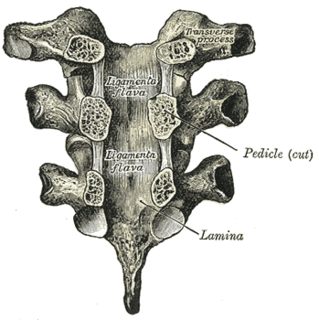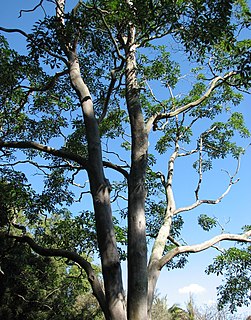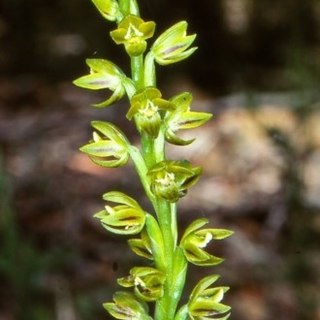
The First Epistle to the Corinthians, usually referred to simply as First Corinthians and often written 1 Corinthians, is one of the Pauline epistles of the New Testament of the Christian Bible. The epistle says that Paul the Apostle and "Sosthenes our brother" wrote it to "the church of God which is at Corinth" 1 Cor.1:1–2 although the scholarly consensus holds that Sosthenes was the amanuensis who wrote down the text of the letter at Paul's direction.

The cor anglais or English horn in North America, is a double-reed woodwind instrument in the oboe family. It is approximately one and a half times the length of an oboe.
NVC community SD1 is the only shingle community in the British National Vegetation Classification system.

The ligamenta flava are ligaments of the spine.

Glaucium flavum is a summer flowering plant in the Papaveraceae family. It is native to Northern Africa, Macronesia, temperate zones in Western Asia and the Caucasus, as well as Europe. The plant grows on the seashore and is never found inland. All parts of the plant, including the seeds, are toxic. It is classed as a noxious weed, in some areas of North America, where it is an introduced species. It is grown in gardens as a short-lived perennial but usually grown as a biennial.

Hymenosporum flavum, or native frangipani, is a rainforest tree which is native to Queensland and New South Wales in Australia and New Guinea. It is the sole species within the genus Hymenosporum, and is closely related to the widespread genus Pittosporum.
Zanthoxylum flavum is a medium-sized tree in the citrus family, Rutaceae. Common names include noyer, West Indian satinwood, yellow sanders, tembetaria, and yellow sandalwood. It is found in Anguilla, Antigua and Barbuda, the Bahamas, Bermuda, Cuba, the Dominican Republic, Guadeloupe, Haiti, Jamaica, Puerto Rico, and the Florida Keys, exclusive of Key West where it has been extirpated. It is threatened by habitat loss and harvesting for its dense, durable wood used in fine woodworking.

Lepidium flavum is a species of flowering plant in the mustard family known by the common name yellow pepperweed. It is native to California, Nevada, and Baja California, where it grows in the Sonoran and Mojave Deserts. The species epithet flavum is Latin for yellow and indicates its flower colour.

Thalictrum flavum, known by the common names common meadow-rue, and yellow meadow-rue, is a flowering plant species in the family Ranunculaceae. It is a native to Caucasus and Russia (Siberia). Growing to 100 cm (39 in) tall by 45 cm (18 in) broad, it is an herbaceous perennial producing clusters of fluffy yellow fragrant flowers in summer.
Cross-origin resource sharing (CORS) is a mechanism that allows restricted resources on a web page to be requested from another domain outside the domain from which the first resource was served. A web page may freely embed cross-origin images, stylesheets, scripts, iframes, and videos. Certain "cross-domain" requests, notably Ajax requests, are forbidden by default by the same-origin security policy.
Flavum is a Latin word meaning "yellow". It is often used in taxonomy for species names typically in scientific names for animals and plants to refer to the flower colour or other aspect of the species.

Allium flavum, the small yellow onion or yellow-flowered garlic, is a species of flowering plant in the genus Allium, which also includes the flowering and culinary onions and garlic. A bulbous herbaceous perennial, it is native to the lands surrounding the Mediterranean, Black, and Caspian Seas, from France + Morocco to Iran + Kazakhstan.
Tragiscoschema is a genus of longhorn beetles of the subfamily Lamiinae, containing the following species:
Tragiscoschema amabile is a species of beetle in the family Cerambycidae. It was described by Perroud in 1855, originally as "Tragocephala amabilis".

Tragiscoschema bertolonii is a species of beetle in the family Cerambycidae. It was described by James Thomson in 1857. It is known from Tanzania, South Africa, the Democratic Republic of the Congo, Angola, Mozambique, and Zimbabwe.
Tragiscoschema elegantissimum is a species of beetle in the family Cerambycidae. It was described by Stephan von Breuning in 1934.
Tragiscoschema holdhausi is a species of beetle in the family Cerambycidae. It was described by Itzinger in 1934.

Tragiscoschema nigroscriptum is a species of beetle in the family Cerambycidae. It was described by Léon Fairmaire in 1897.
Aeromicrobium flavum is a Gram-positive facultatively anaerobic and non-motile bacterium from the genus of Aeromicrobium which has been isolated from air from the Wuhan University campus in China.

Prasophyllum flavum, commonly known as the yellow leek orchid, is a species of orchid endemic to eastern Australia. It has a single tubular, green leaf with only a short free section and up to fifty scented, yellowish-green flowers.











